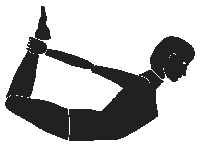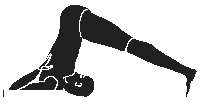Introduction

As per the rule of nature if any changes take place in the body, it has to respond to such changes. Delayed menstruation or menstrual problem is one of the ways in which women's body responds to these changes. Disturbances of the menstrual and reproductive functions are extremely common and are a source of continual suffering for many women throughout their lives. In many countries the topic of reproductive function is traditionally veiled in secrecy, and as a result, many women do not fully understand the natural processes and cycles occurring in their bodies, or are misled by superstitions and false or inaccurate information.
Yoga and Menstrual Disorder
Most of the women face menstrual problems at least once in a life time. Yoga is one of the illustrious ways to cure menstrual delays. Read on to know which yoga postures can help to deal with delayed menstruation.Practising yoga is one of the ways of correcting menstrual delays. There are several ways of treating menstrual delays. However, most of the women prefer to correct such menstrual problems through yoga. Yoga is preferred by many as it is regarded as one of the natural ways of treating menstrual problems. Women should practice yoga to keep themselves fit and fine keeping in mind their physique, age and physical activities. Daily practice will help them to improve on their figure, impart energy and prevent various uterine and ovarian disorders during pregnancy and childbirth. Yoga is precious gift which can enrich human life. Yoga helps to get a balanced body and mind. Practicing yoga not only helps you to get rid of health problems but also helps to reduce stress. Thus it is very important to practice yoga regularly to obtain maximum benefit out of it and live a healthy life.YOGA POSES FOR MENSTRUAL DISORDER
The Bow Pose
The body form in this asana resembles a bow or 'dhanur'. It is one of the best asana for activating and strengthening the joints of the body. It has some special benefits for women.Wheel Pose
Chakra, from the root cak ("to move") means wheel and therefore this is the Wheel Posture. The chakra-asana is also known as the urdhva-dhanurasana. Urdhva means raised, elevated or upright and dhanur means bow. Both "wheel posture" and "raised bow posture" describe the appearance of this asana.Cat Pose
The Cat Yoga Pose teaches you to initiate movement from your center and to coordinate your movement and breath. These are two of the most important themes in Asana practice. The alignment of your center depends on the positioning of your pelvis. Therefore, think of your hip positioning as the center of each pose. This is important because your spine is the most significant line of energy in every pose and because the way your spine elongates from your center depends solely on which way your pelvis is turning.Camel Pose
The camel pose is a powerful posture for stretching the spine, back muscles, shoulders and arms. It is best to practice it later in your asana routine after most of the muscles are limber and and you have worked the back and shoulders.Hero Pose
The Sanskrit word vira means hero, brave or eminent man, or warrior. The Hero Pose is one of the basic Seated Postures, also excellent for Meditation. The internal rotation of the upper legs and knees is opposite to the movement involved in the Lotus Pose; as such, it both loosens the hips, knees, and ankles in preparation for the Lotus Pose and acts as a mild counterpose. The Hero Pose is also the starting Yoga position for several forward bends, backward bends, and twists.Cobblers Pose
Cobbler's pose in yoga is a great groin and back stretching yoga pose. As with may hip opening poses, Cobblers pose is especially good for women during menses and menopause because it stimulates the ovaries; it is also very good for pregnant women and is thought to ease child birthing pains when practiced consistently through the entire pregnancy. There are also benefits for men because Cobblers pose stimulates the prostate gland. This is a simple, luxurious stretch that soothes the entire pelvic floor, releases tension from the lower back, as well as toning the legs and feet.YOGA ASANAS FOR MENSTURAL DISORDER
BHUJANGAASANA
Bhujanga or Cobra posture is a popular asana and it is always practiced as the first in a series of backward bending movements. In this asana the spine is arched backward gently promoting flexibility. It has some special benefits for women. Helps relieve problems of the uterus and ovaries and menstrual problems. A regular practice of this asana makes child birth easy.
Steps
- Lie down with your legs joint, raising your torso and balancing with your palms on the floor with the forehead touching the floor.
- Similarly, fold the right leg over the left and place the right heel by the side of the left hip. Both the soles should face upwards.
- Inhale; bringing your head up, slightly touching your nose first then the chin against the floor. At this instance raise your hands and make use of your back muscles to elevate your chest as high as possible. Hold for a few seconds breathing deep and exhale returning to position 1, with the chin up through the entire process.
- Breath in, stretch out as position 1 using your hands to push up the torso this time, go on up till you curve from the middle of the spine, hold, deep breathe and slowly come down.
- Inhale raising your torso like before, this time going on up towards your back until you feel the back bending in from the neck to the bottom of the spine and breathe normal.
- To finish up, move your hands towards yourself, arms straight, lift the torso straight. Now separate both the legs, push the chest out with knees bent, drop the head back trying to touch the feet to the head, breathe normal and come down slowly to sitting position.
DHANURASANA

Steps
- Lie down with face and the forehead touching the ground, arms extended along side the body and legs straight.
- Bend your legs at the knees towards the hips, bringing them forward so that they can be held firmly by the hands at the ankles on the respective sides.
- While inhaling, stretch your legs backwards and raise your thighs, chest and head simultaneously. Hands should be kept straight. The weight of the body should be on the navel. Knees should be kept close, if possible, with eyes looking upwards. This posture should be retained for at least a few seconds, holding the breath.
MATSYASANA

Steps
- Sit in Padmasana.
- Slowly take the help of your elbows to lie down on your back.
- Slowly lie on your back completely.
- Now with the help of elbows or palms bend your head backward and place middle of the head on the ground.
- Catch hold of the toes with your index fingers and place the elbows on the ground.
- While returning to original position, release the toes and taking the help of your hands straighten your head.
- Now taking the help of elbow sit in padmasana.
HALASANA

Steps
- Lie down on your back with the legs joined and hands on your sides in a straight posture.
- Breathe in and lift up your legs, exhale and inhale again.
- Get your hips up away from the floor.
- Hold up your back with your hands with both the elbows close to one another.
- Breathe out and get your legs downward behind your head without bending the knees. It is not required for you to touch the floor with your feet, depends mostly on how flexible you are, stretch as much as your body allows.
- Continue breathing in this posture.
- Now with your feet bent, push up your trunk and heels back and get back to position 1.
- Breathing deep and slow, come back to sitting position.
SARVANGAASANA
Sarvanga means all the parts of the body and this asana benefits all parts of the body, particularly the thyroid gland, resulting in proper digestion, blood circulation and respiration.
Steps
- Exhale and Inhale deeply while raising your both legs and spine until they make angle of 90 degree with the floor. Attain the Uttanpadasana posture.
- Exhaling raise the waist and push the legs backward over the head. Support the waist with both the hands, using your hands get the legs, waist and back in one straight line and stabilize them in this position, stretch the toes towards ceiling. Keep your spine, legs straight and sight on the toes.
- When the body has been raised to a maximum point stay there and breathe slowly and deeply with the abdomen and concentrate on the thyroid gland. Chin is placed in the Jugular notch forming a tie which is called 'Jalandhar Bandha'. Stay in this position for ten to fifteen seconds during first week. Gradually develop the time to one minute in a month.
- To come out of this posture, Inhale and exhaling, slightly lower the legs towards head and maintaining the balance of the body remove the hands supporting the waist back to the normal position. Inhaling, place the waist on the ground keeping legs straight as in the Uttanpadasana.
- Exhaling, bring legs back to the normal position without jerk or speed.
Diseases Related to Scorpio |
||


